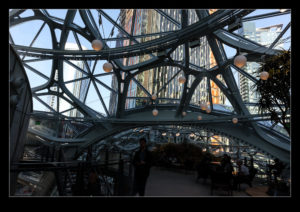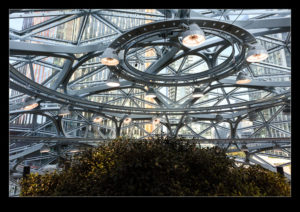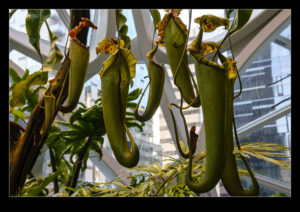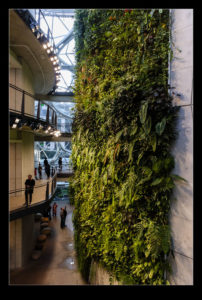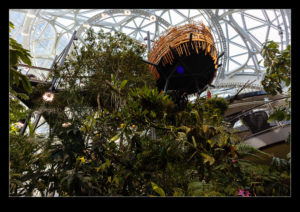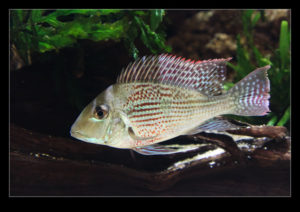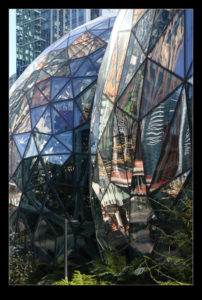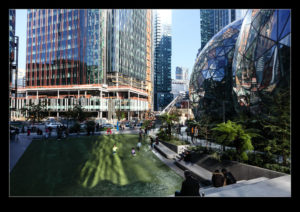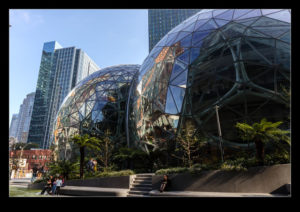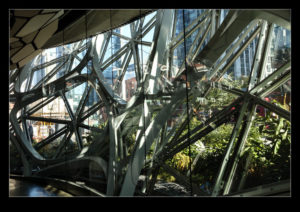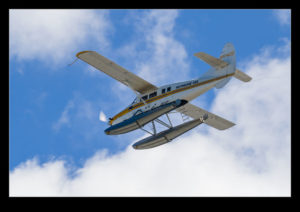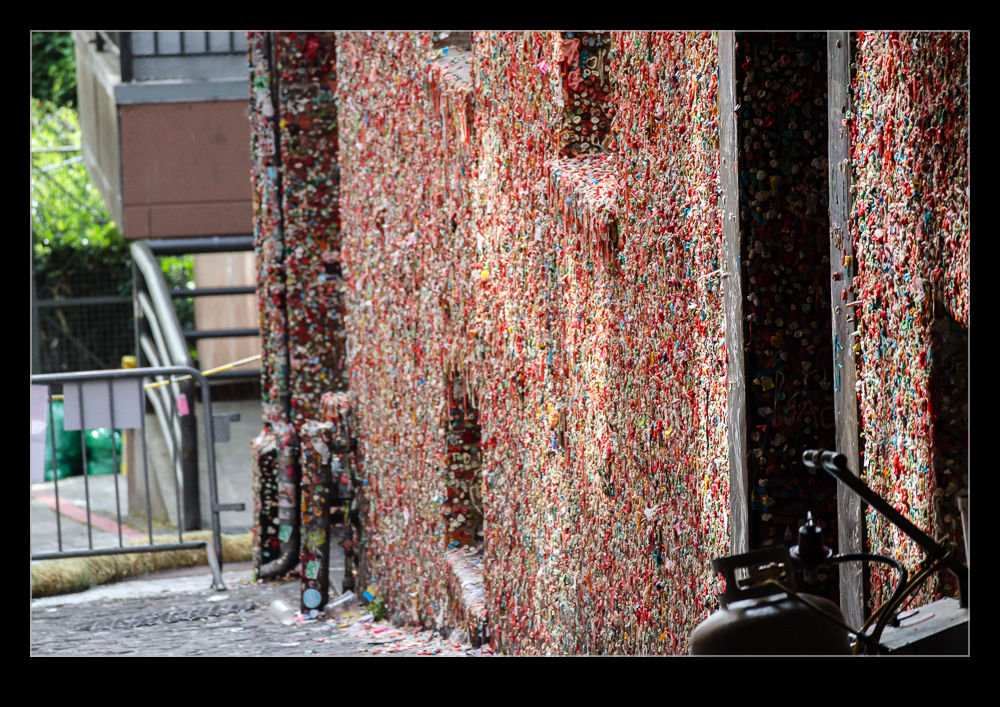 No story, just a photo. This one of the Space Needle was one I took with my phone as we were walking back from a work event. Thought it came out quite well.
No story, just a photo. This one of the Space Needle was one I took with my phone as we were walking back from a work event. Thought it came out quite well.
Tag Archives: seattle
XF8U-1
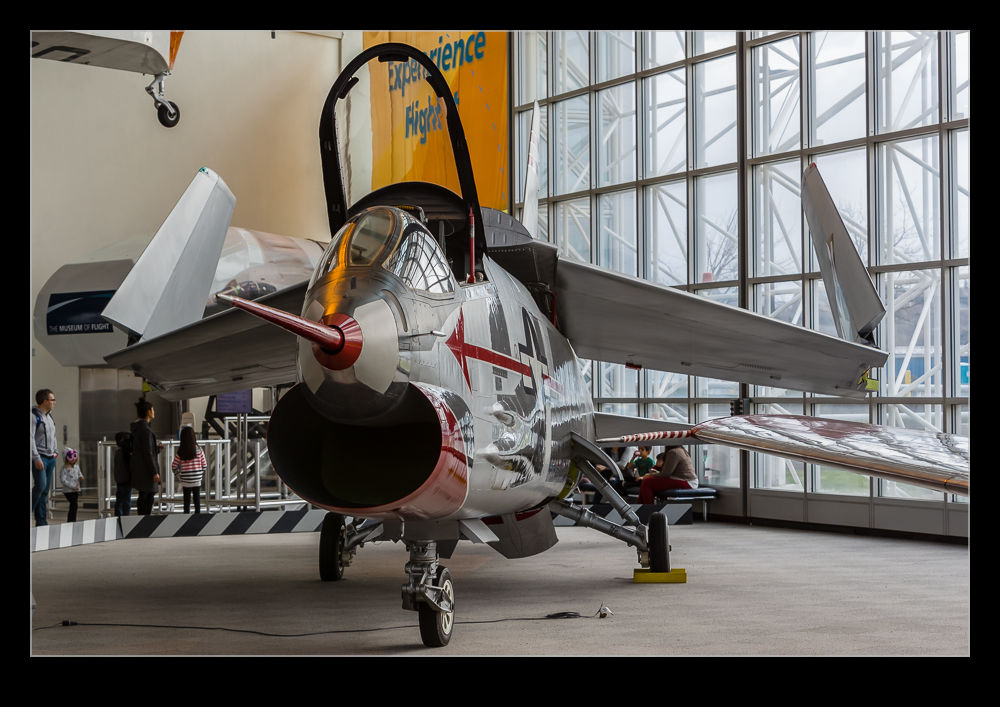 I certainly won’t stand out from the crowd by claiming that I am a bit of a fan of the F-8 Crusader. Plenty of people think it is a cracking jet. I didn’t get to see many of them. French Navy jets were still in service and, while the RF-8s were in use with the Navy at the beginning of my interest in aviation, I don’t think I ever saw in in service example. Doesn’t stop me liking them though. The Museum of Flight has the prototype jet in their collection. Prior to the unification of the type identifiers between the services, it was known as the XF8U-1.
I certainly won’t stand out from the crowd by claiming that I am a bit of a fan of the F-8 Crusader. Plenty of people think it is a cracking jet. I didn’t get to see many of them. French Navy jets were still in service and, while the RF-8s were in use with the Navy at the beginning of my interest in aviation, I don’t think I ever saw in in service example. Doesn’t stop me liking them though. The Museum of Flight has the prototype jet in their collection. Prior to the unification of the type identifiers between the services, it was known as the XF8U-1.
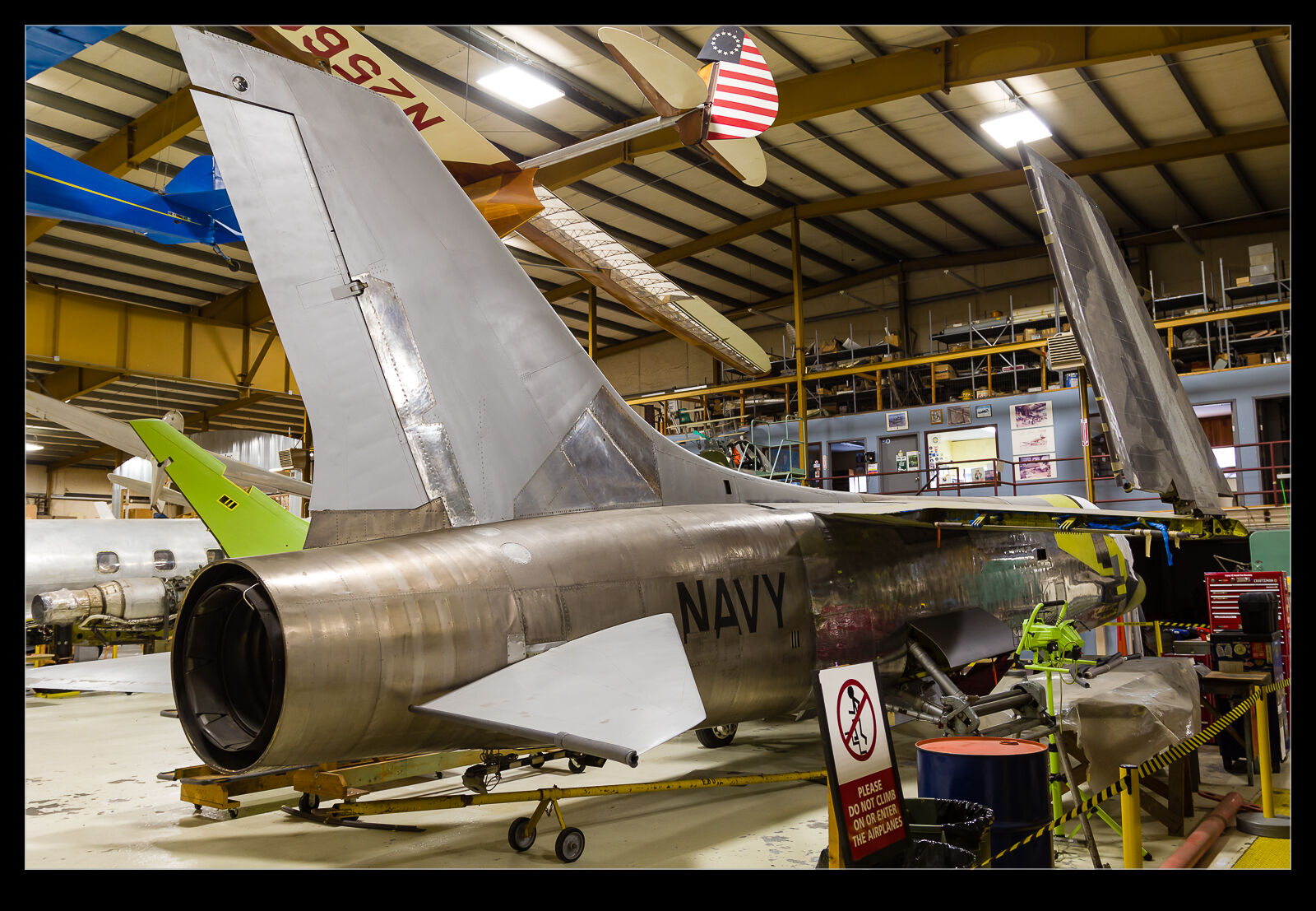 I first saw it while it was undergoing restoration at the museum’s facility at Paine Field. My first visit there was when it was free. You could just show up and wander around. Now you have to pay to get in but it is still a good visit to make. Restoration is when things are a lot less glamorous but you do see the work underway to makes things look great.
I first saw it while it was undergoing restoration at the museum’s facility at Paine Field. My first visit there was when it was free. You could just show up and wander around. Now you have to pay to get in but it is still a good visit to make. Restoration is when things are a lot less glamorous but you do see the work underway to makes things look great.
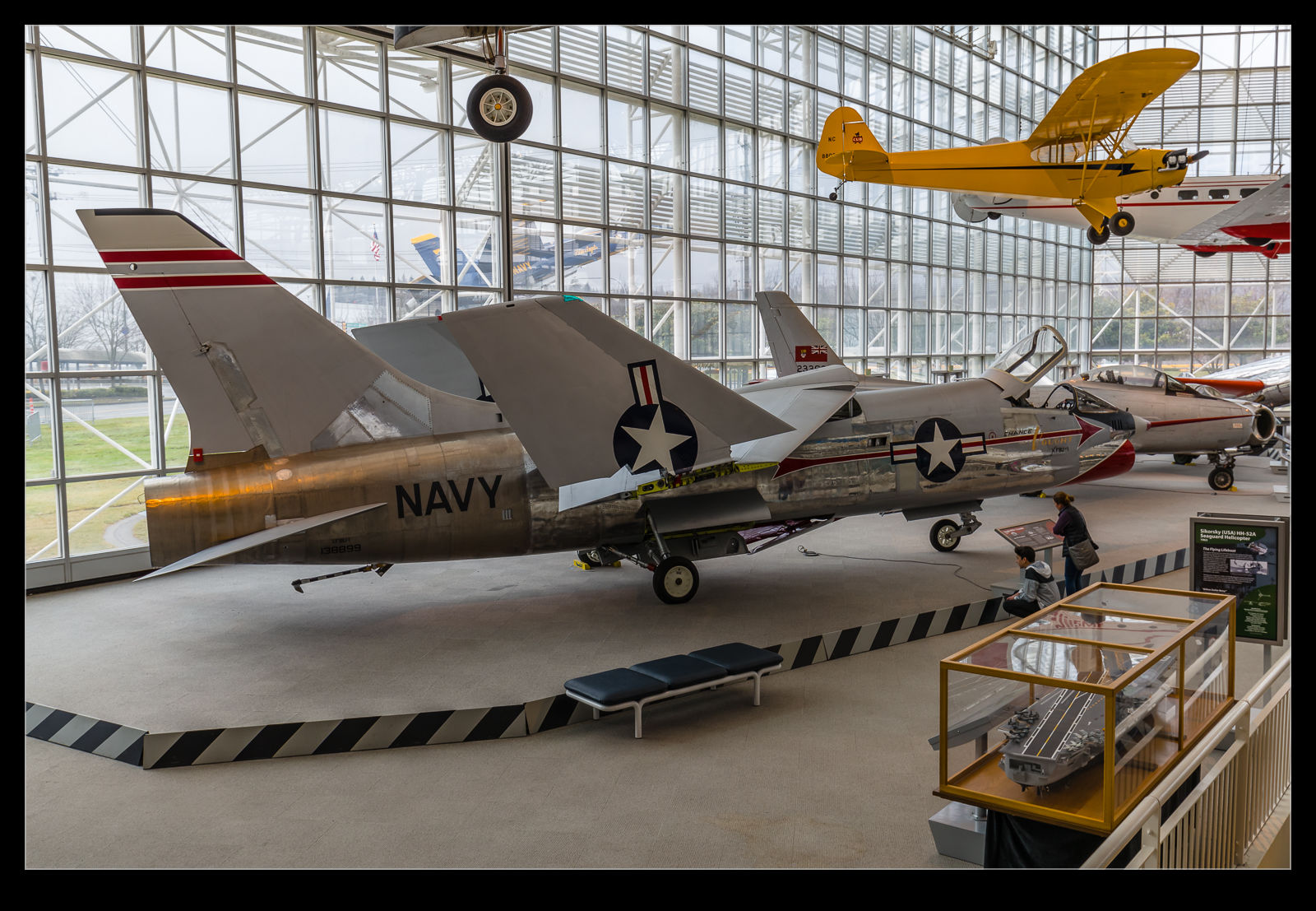 Now the jet has been moved to the main museum facility at Boeing Field. It is polished to a fine finish and is complete with an air data boom. The markings it carries appear to be authentic based on some original photos of the aircraft and, with its location close to the window, it does gleam nicely. Oh to find someone with a lot of money and a desire to have one of these jets airworthy again.
Now the jet has been moved to the main museum facility at Boeing Field. It is polished to a fine finish and is complete with an air data boom. The markings it carries appear to be authentic based on some original photos of the aircraft and, with its location close to the window, it does gleam nicely. Oh to find someone with a lot of money and a desire to have one of these jets airworthy again.
A Stinking Rarity
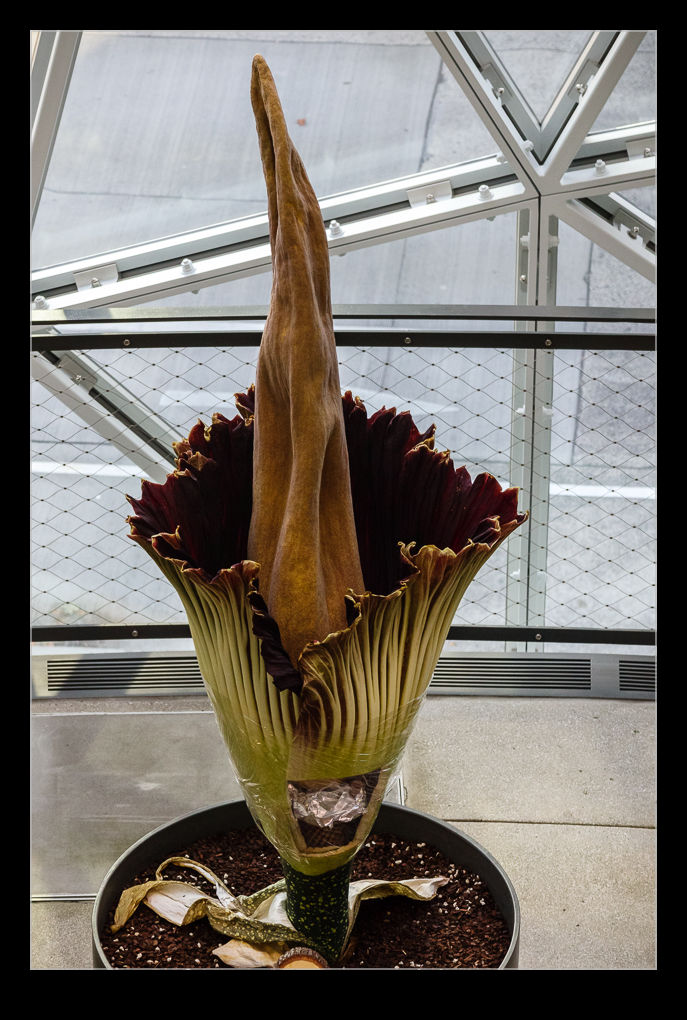 Some plants bloom frequently. Others bloom once a year. What is slightly more unusual is a plant that only blooms once every 7-10 years. The Titan Arum is one such plant and an example lives in the Amazon Spheres in Seattle. Purely by coincidence, we happened to visit the Spheres when it was blooming. We had actually missed the peak opening by a day and it was starting to close up again. It had also had a hole cut into the side to allow pollination artificially. But this was a small price to pay for seeing something so unusual.
Some plants bloom frequently. Others bloom once a year. What is slightly more unusual is a plant that only blooms once every 7-10 years. The Titan Arum is one such plant and an example lives in the Amazon Spheres in Seattle. Purely by coincidence, we happened to visit the Spheres when it was blooming. We had actually missed the peak opening by a day and it was starting to close up again. It had also had a hole cut into the side to allow pollination artificially. But this was a small price to pay for seeing something so unusual.
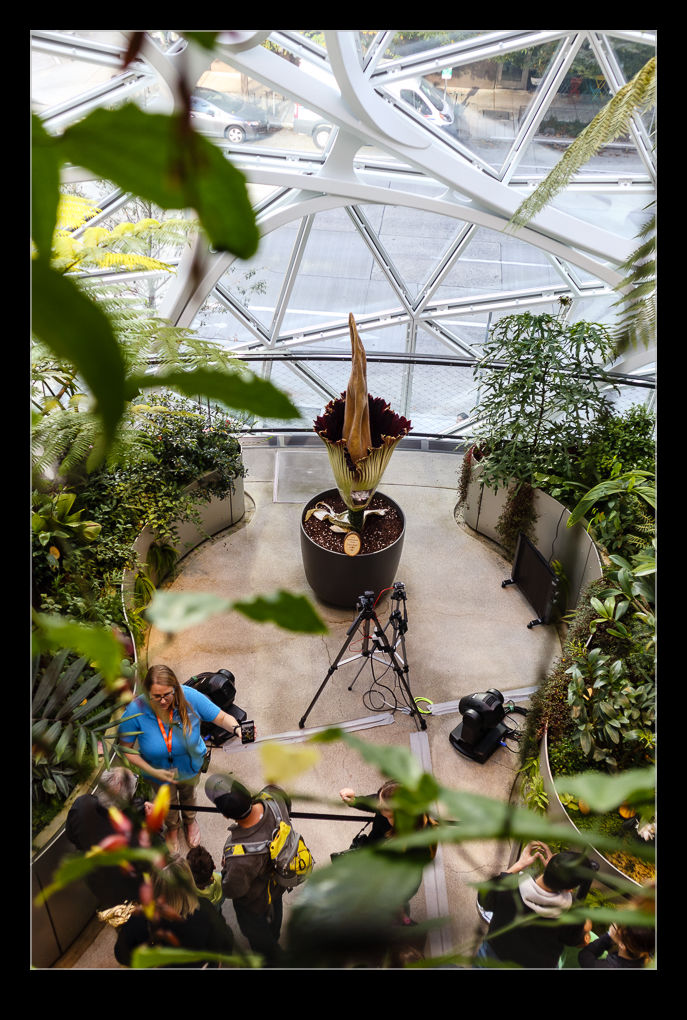 One feature the plant is known for is a smell of rotting flesh when it is blooming. This is supposed to attract insects that then assist with pollination. There was a bit of an odor but, to be honest, I wasn’t conscious of it being too bad. Maybe there is a peak period of stinkiness and we missed it or maybe the story has been slightly overblown. Either way, it was very lucky that we happened to be there during the blooming process and now we might have to wait a few years before it happens again.
One feature the plant is known for is a smell of rotting flesh when it is blooming. This is supposed to attract insects that then assist with pollination. There was a bit of an odor but, to be honest, I wasn’t conscious of it being too bad. Maybe there is a peak period of stinkiness and we missed it or maybe the story has been slightly overblown. Either way, it was very lucky that we happened to be there during the blooming process and now we might have to wait a few years before it happens again.
Amazon Spheres
 When Chris and Sam visited, Sam had a list of things she wanted to do. I have to admit that one of those things I had no idea existed until she mentioned it. Having been here eighteen months and also having been through the area involved a couple of times, this was a bit embarrassing. The subject is the Amazon Spheres. Amazon seems to control a lot of territory in Seattle these days but, while most of this is in traditional office space, the Spheres are something different.
When Chris and Sam visited, Sam had a list of things she wanted to do. I have to admit that one of those things I had no idea existed until she mentioned it. Having been here eighteen months and also having been through the area involved a couple of times, this was a bit embarrassing. The subject is the Amazon Spheres. Amazon seems to control a lot of territory in Seattle these days but, while most of this is in traditional office space, the Spheres are something different.
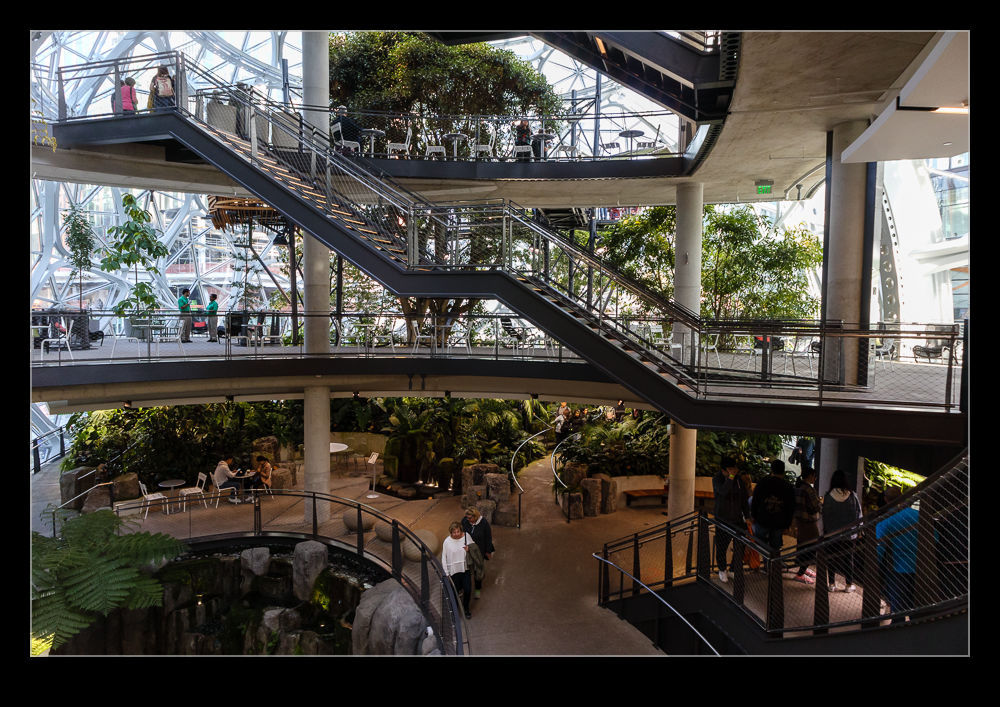 They are an environmental space that encompasses a wide range of plant life. It is designed to be used by employees as they have meetings or not to work alone for a while. They can relax in these spaces. At the weekends, though, it is sometimes made available for the public to visit for free. You just have to book a slot. We didn’t know about this when Sam and Chris were here so we only saw them from the outside. However, we did then know a little more and were able to plan a visit when Tom and Lenore came to stay.
They are an environmental space that encompasses a wide range of plant life. It is designed to be used by employees as they have meetings or not to work alone for a while. They can relax in these spaces. At the weekends, though, it is sometimes made available for the public to visit for free. You just have to book a slot. We didn’t know about this when Sam and Chris were here so we only saw them from the outside. However, we did then know a little more and were able to plan a visit when Tom and Lenore came to stay.
 The interior of the Spheres is something that you can guess at when you are looking from outside but being inside is totally amazing. The huge diversity of plant types throughout the space is incredible. The engineering of the spheres themselves and of the stairs and walkways within are very cool to someone with that sort of background like me. The ability to sustain the plants and keep them fed and watered is impressive and every turn takes you to something new and interesting. Couple that with some cool workspaces for the staff to use for meetings and you have a unique building complex. I would happily go back there on another occasion just to hang out and relax while possibly photographing more of the plants. I could probably have multiple posts of shots from this place but I shall make do with a combination of architectural shots and some of the plants for now. If you are planning on coming to Seattle, try and time it to coincide with one of the open weekends and give yourself enough time.
The interior of the Spheres is something that you can guess at when you are looking from outside but being inside is totally amazing. The huge diversity of plant types throughout the space is incredible. The engineering of the spheres themselves and of the stairs and walkways within are very cool to someone with that sort of background like me. The ability to sustain the plants and keep them fed and watered is impressive and every turn takes you to something new and interesting. Couple that with some cool workspaces for the staff to use for meetings and you have a unique building complex. I would happily go back there on another occasion just to hang out and relax while possibly photographing more of the plants. I could probably have multiple posts of shots from this place but I shall make do with a combination of architectural shots and some of the plants for now. If you are planning on coming to Seattle, try and time it to coincide with one of the open weekends and give yourself enough time.
Space Needle Air Traffic
 The top of the Space Needle is a good place to watch the floatplane traffic in to Lake Union. They tend to fly really close by. Shooting through the glass is not ideal but the passing Otters are too good to pass up. If you can, getting to the gaps between the glass is a good idea but it is hard to do this and get a good angle on the planes as they pass. Boeing also helped out with an Oman Air 737 Max taking off from Boeing Field and coming our way.
The top of the Space Needle is a good place to watch the floatplane traffic in to Lake Union. They tend to fly really close by. Shooting through the glass is not ideal but the passing Otters are too good to pass up. If you can, getting to the gaps between the glass is a good idea but it is hard to do this and get a good angle on the planes as they pass. Boeing also helped out with an Oman Air 737 Max taking off from Boeing Field and coming our way.
Cleaning the Gum Wall
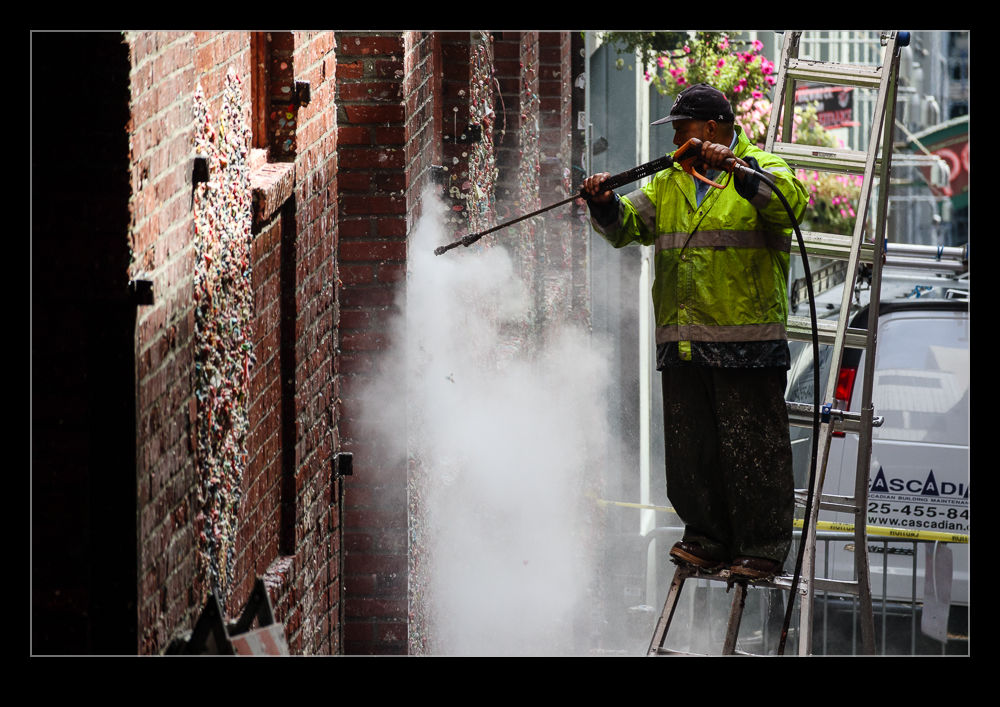 One of the more unpleasant tourist attractions in Seattle is the gum wall. That made it on to the blog in this post from a few years ago. We went to check it out when we had visitors staying recently. However, we had chosen poorly (or well depending on your perspective). They were in the process of cleaning the wall. Some poor guy was busy with a jet washer blasting the crap off the walls. Not a nice job I imagine.
One of the more unpleasant tourist attractions in Seattle is the gum wall. That made it on to the blog in this post from a few years ago. We went to check it out when we had visitors staying recently. However, we had chosen poorly (or well depending on your perspective). They were in the process of cleaning the wall. Some poor guy was busy with a jet washer blasting the crap off the walls. Not a nice job I imagine.
Starbucks Number One
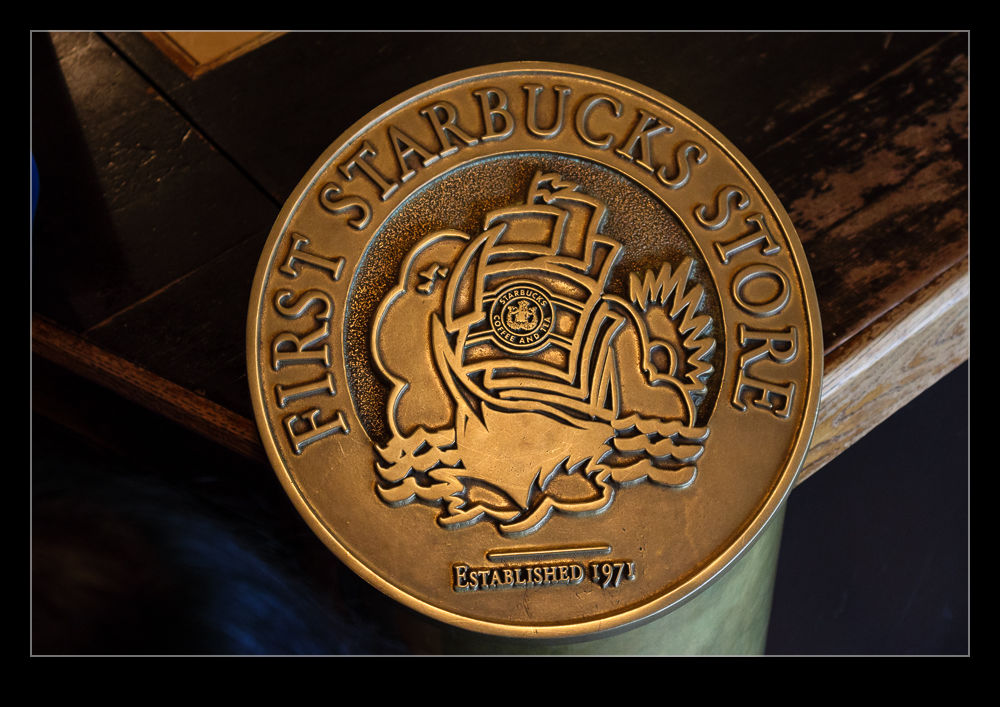 When you don’t drink coffee, as I don’t, Starbucks is not something you pay much attention to. However, when you have the tourist route to do in Seattle, the first Starbucks shop down at Pike Place is part of the routine. You have to get in line if you want to order something because there are plenty of people also looking to check the place out. Meanwhile, some musicians are set up outside the door to keep you entertained while you wait.
When you don’t drink coffee, as I don’t, Starbucks is not something you pay much attention to. However, when you have the tourist route to do in Seattle, the first Starbucks shop down at Pike Place is part of the routine. You have to get in line if you want to order something because there are plenty of people also looking to check the place out. Meanwhile, some musicians are set up outside the door to keep you entertained while you wait.
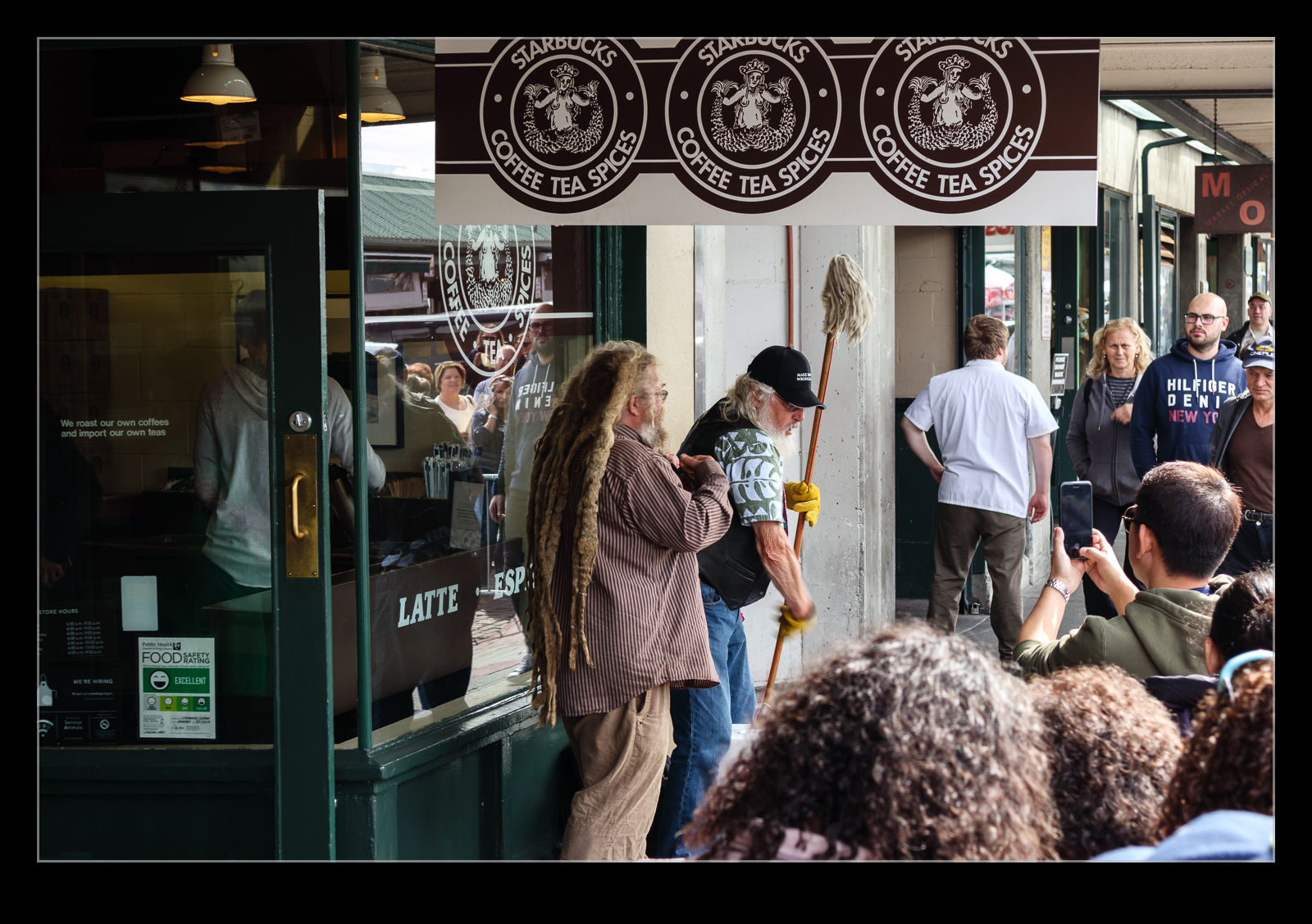 Once you get inside, there is coffee to be ordered. There are also plenty of souvenirs which seemed to be selling well. Since I didn’t have anything to buy, I was able to watch everyone else doing their thing.
Once you get inside, there is coffee to be ordered. There are also plenty of souvenirs which seemed to be selling well. Since I didn’t have anything to buy, I was able to watch everyone else doing their thing.
Stadium Over the Water
 This post was originally going to be based on a shot I got of the University of Washington’s football stadium that I took while were hiking in the park nearby. However, things moved on a bit and I wasn’t too bothered by the shot. Then, as I was coming home from a trip, I was sitting on the left side of the plane as we made our approach over Seattle. I was looking straight down on the university campus and the stadium. I figured this would be a more interesting view for a post so finally the topic makes its way on to the blog.
This post was originally going to be based on a shot I got of the University of Washington’s football stadium that I took while were hiking in the park nearby. However, things moved on a bit and I wasn’t too bothered by the shot. Then, as I was coming home from a trip, I was sitting on the left side of the plane as we made our approach over Seattle. I was looking straight down on the university campus and the stadium. I figured this would be a more interesting view for a post so finally the topic makes its way on to the blog.
Details of a Pegasus
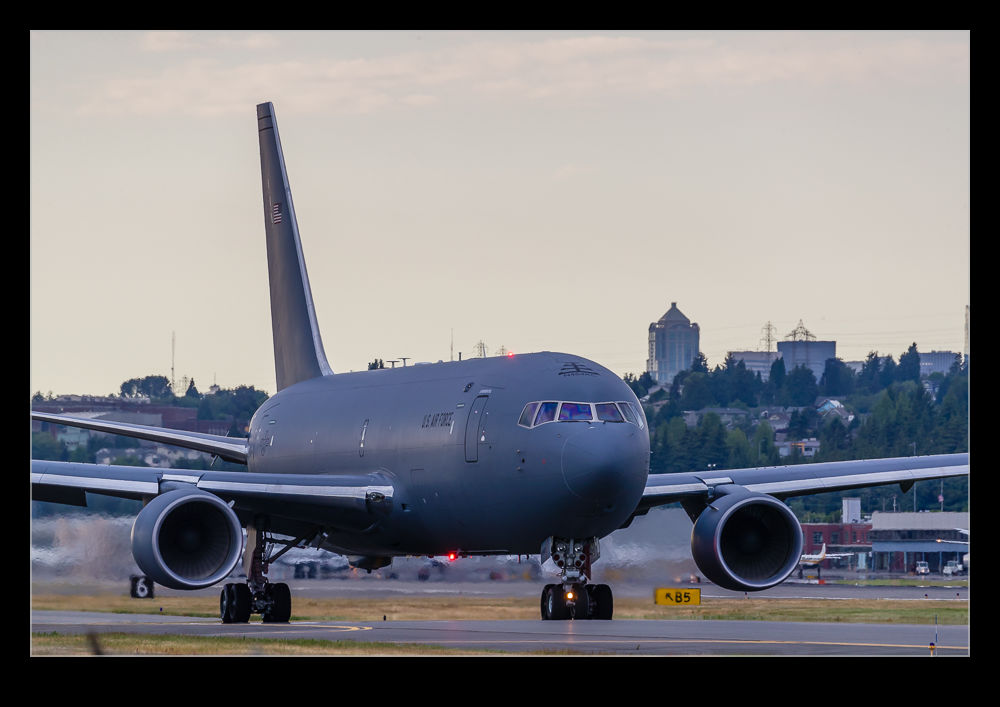 The KC-46 Pegasus test program drags on. The delivery of jets to the USAF is still not happening and the number of jets built increases but they are stacking up at Paine Field and Boeing Field. Meanwhile the test jets are working through test points and endeavoring to prove that the problems identified in previous tests are now resolved. I have seen a few jets now and shot them in varying conditions from sun to downpours.
The KC-46 Pegasus test program drags on. The delivery of jets to the USAF is still not happening and the number of jets built increases but they are stacking up at Paine Field and Boeing Field. Meanwhile the test jets are working through test points and endeavoring to prove that the problems identified in previous tests are now resolved. I have seen a few jets now and shot them in varying conditions from sun to downpours.
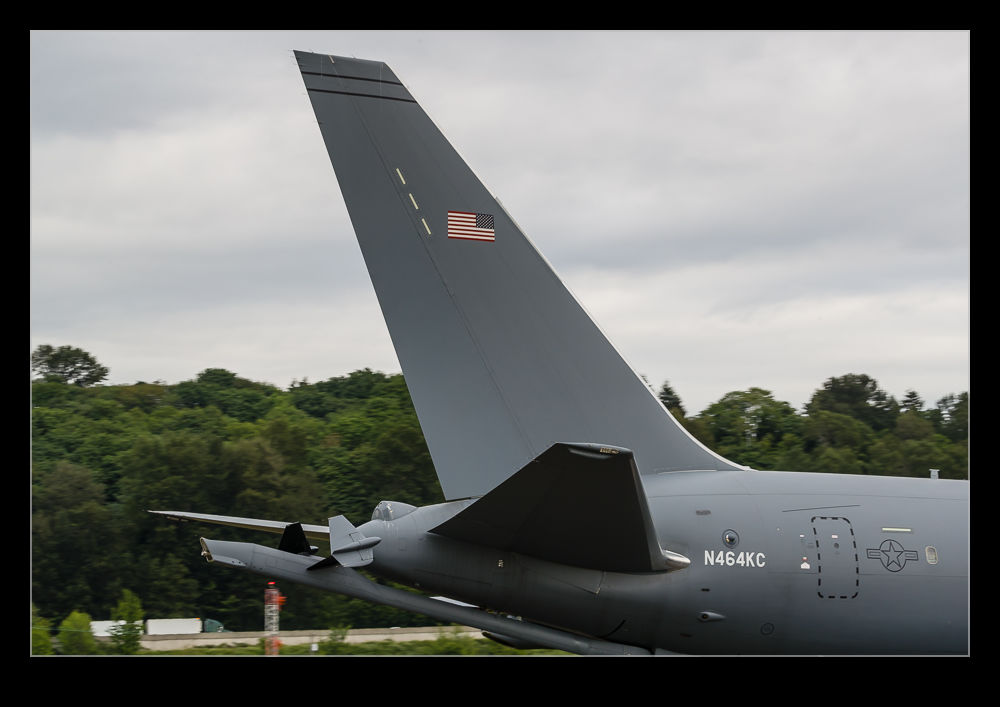 I was at Boeing Field one evening waiting to pick up someone at SeaTac later in the evening when one of the test jets taxied out from the Boeing ramp at the north of the field and came right by me prior to departing on another mission. The jet was configured with the boom and the underwing pods so the planned final configuration. As it came by, I decided to get some shots of the airframe to get a better idea of what the various parts look like.
I was at Boeing Field one evening waiting to pick up someone at SeaTac later in the evening when one of the test jets taxied out from the Boeing ramp at the north of the field and came right by me prior to departing on another mission. The jet was configured with the boom and the underwing pods so the planned final configuration. As it came by, I decided to get some shots of the airframe to get a better idea of what the various parts look like.
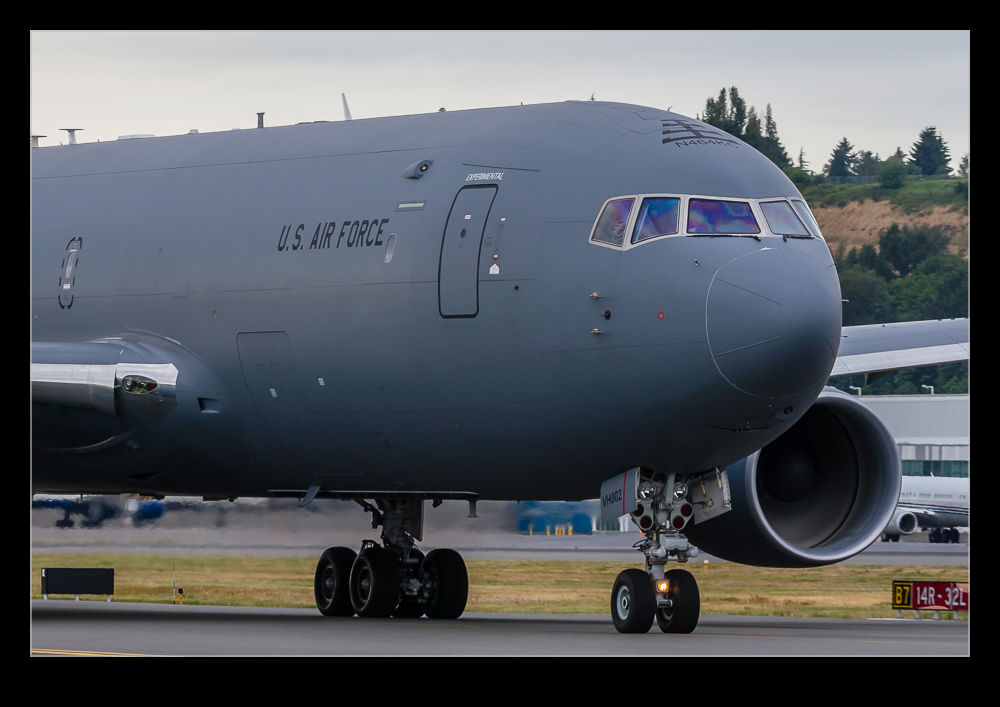 The airframe is the familiar 767 although there are some changes structurally. The cockpit is updated too but you can’t see that from the outside. However, you can see the various sensors mounted around the airframe which, I assume, are radar detectors. Above the cockpit is the receiver receptacle for the refueling boom to allow the jet to receive as well as dispense fuel. You can’t see much from the ground other than the markings to guide the boomer (and the markings that identify which jet it is).
The airframe is the familiar 767 although there are some changes structurally. The cockpit is updated too but you can’t see that from the outside. However, you can see the various sensors mounted around the airframe which, I assume, are radar detectors. Above the cockpit is the receiver receptacle for the refueling boom to allow the jet to receive as well as dispense fuel. You can’t see much from the ground other than the markings to guide the boomer (and the markings that identify which jet it is).
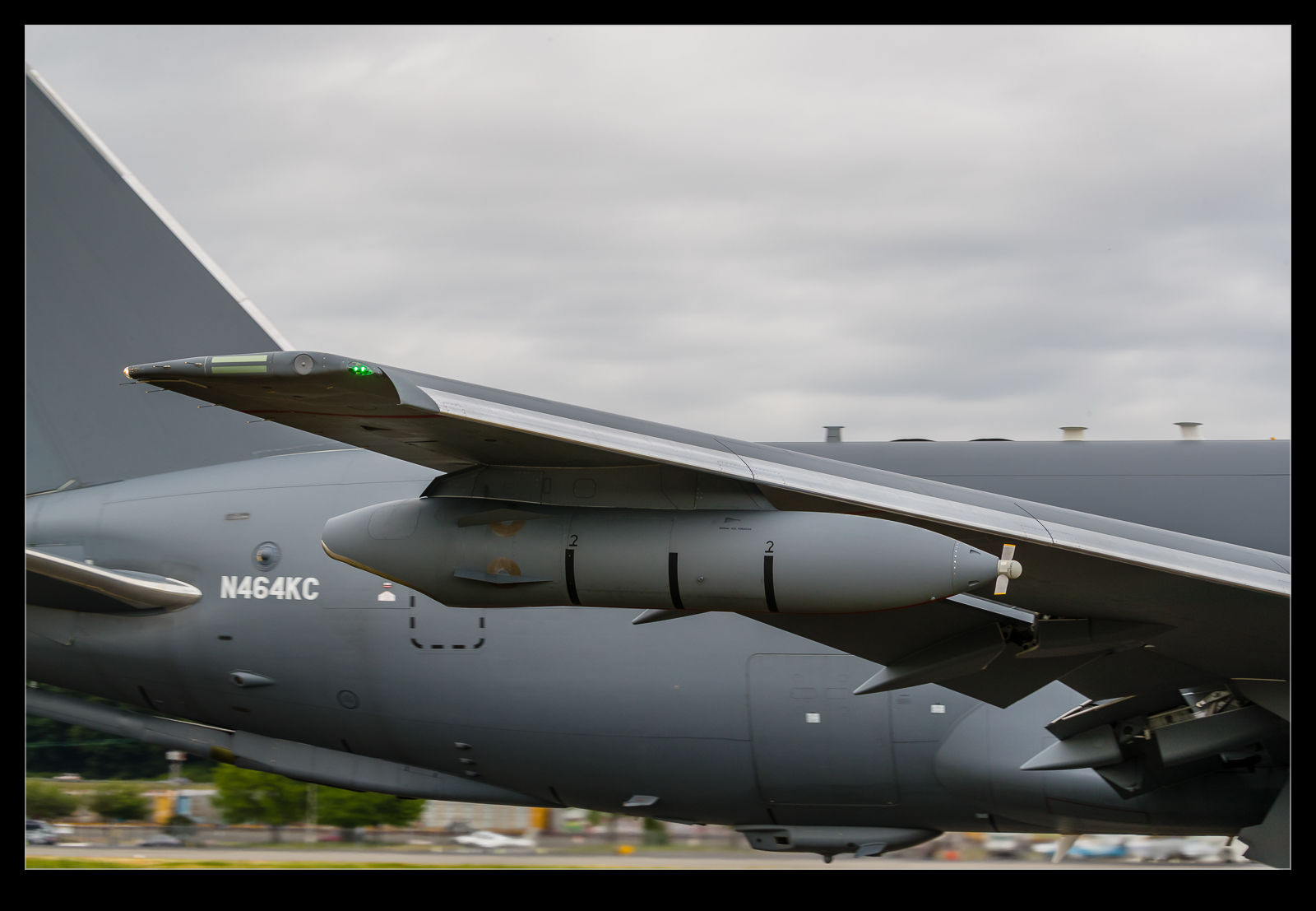 The underwing refueling pods are a source of some of the troubles the program is having. Apparently, the supplier in the UK underestimated what was required to achieve he civil certification that is part of the contract requirements. The pods may not be cleared when the initial jets finally enter service. Modern pods have a more streamlined look. Earlier pods have a blunt back end that the hose and drought come out of. The modern pods and more streamlined and the rogue comes out of a ramp in the bottom of the pod.
The underwing refueling pods are a source of some of the troubles the program is having. Apparently, the supplier in the UK underestimated what was required to achieve he civil certification that is part of the contract requirements. The pods may not be cleared when the initial jets finally enter service. Modern pods have a more streamlined look. Earlier pods have a blunt back end that the hose and drought come out of. The modern pods and more streamlined and the rogue comes out of a ramp in the bottom of the pod.
The back end has the boom. Given how many boom tankers Boeing has produced, modern booms seem to cause them a lot of trouble. This one is still one of the major defects with the jet. Hopefully it will be resolved soon. The boomer does not have a window like the earlier jets but instead uses stereo video cameras to give the boomer the view of what is going on. I assume some of the apertures around the rear fuselage are for the cameras to support this functionality. We shall see how long it is before we see this being used for real by the USAF as opposed to the test team.
NOTAR Sneaks Up on Me (I Guess It Works)
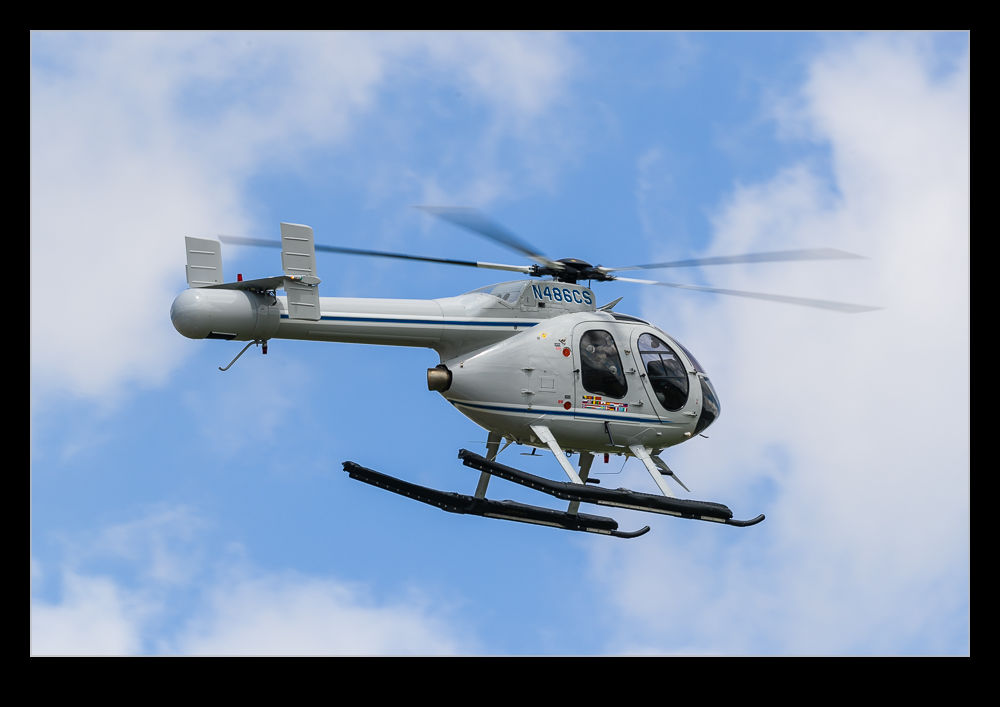 In the late 80s and early 90s, NOTAR was a big deal. McDonnell Douglas Helicopters (as it then was) had come up with the concept of NO TAil Rotor and was pushing it hard. It was seen as a safer approach, quieter and potentially more efficient. The last one may not have been the case as, given how long the concept has been around, the successor company has continued to build helicopters with tail rotors as has just about everyone else (unless you count a Fenestron as not a tail rotor). This example came in to BFI right over my head. He had called up on the radio so I should have known but the quiet aspect of the aircraft was proven as I had no idea he was there until he passed directly over me.
In the late 80s and early 90s, NOTAR was a big deal. McDonnell Douglas Helicopters (as it then was) had come up with the concept of NO TAil Rotor and was pushing it hard. It was seen as a safer approach, quieter and potentially more efficient. The last one may not have been the case as, given how long the concept has been around, the successor company has continued to build helicopters with tail rotors as has just about everyone else (unless you count a Fenestron as not a tail rotor). This example came in to BFI right over my head. He had called up on the radio so I should have known but the quiet aspect of the aircraft was proven as I had no idea he was there until he passed directly over me.

